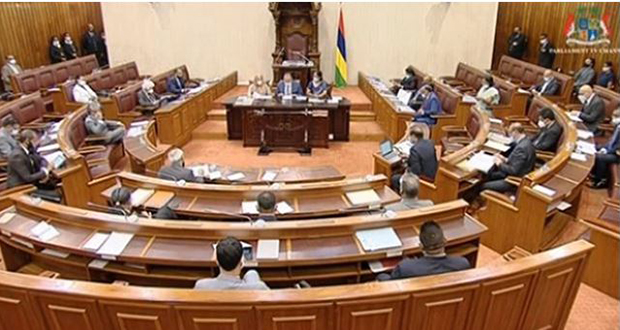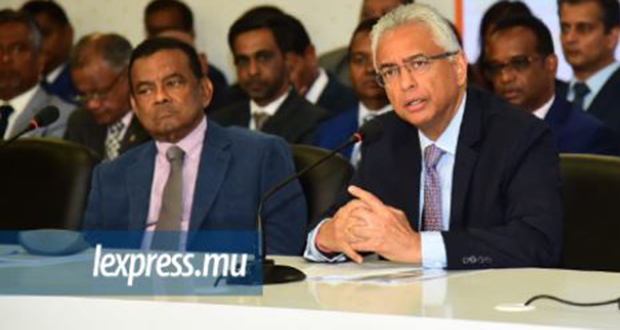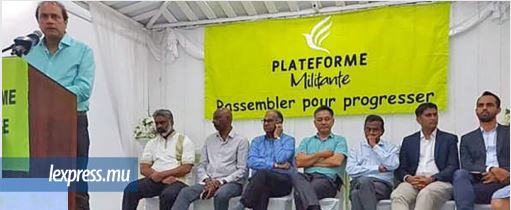Publicité
Politics: Why do the ex-MMM allies of the MSM now want to merge into a single party?
Par
Partager cet article
Politics: Why do the ex-MMM allies of the MSM now want to merge into a single party?

In mid-December, three of the government’s allies from the MMM – Ivan Collendavelloo, Steven Obeegadoo and Alan Ganoo – announced their plan to unify their parties into a single organization. Let’s see why these parties have no other choice, but to combine.
Why the intended merger…
The three smaller, ex-MMM allies of the ruling MSM led by Prime Minister Pravind Jugnauth announced in mid-December that they are looking to formally come together into a single political party. That Ivan Collendavelloo’s Muvman Liberater (ML), Steven Obeegadoo’s Platforme Militante (PM) and Alan Ganoo’s Mouvement Patriotique (MP) were mulling unification was announced by Obeegadoo at the end-ofyear party of the PM on December 14. “We must ensure that the three militant movements work together in solidarity with the MSM,” the deputy prime minister (DPM) said at that event. Collendavelloo added that he hoped the three parties would reunify within three months. “This is a normal process happening with an election nearing,” says historian and former academic at the University of Mauritius, Jocelyn Chan Low.
One reason for the three parties looking to come together is that since each of them split off from the MMM, they have run into trouble keeping their individual parties afloat. Out of the three, Collendavelloo’s ML is the oldest and started off as by far the strongest of the three. By December 2016, Collendavelloo had bagged the No. 2 spot in government, becoming DPM and controlling a string of MPs. However, that soon began falling apart, crumbling under multiple blows caused by the scandal around Alvaro Sobrinho that cost the ML’s hand-picked president, Ameenah Gurib-Fakim, her job; and infighting within the ML that resulted in members such as Anwar Husnoo either jumping ship to join the MSM proper.
Furthermore, Collendavelloo was struggling to paper over differences with disgruntled members while being at the same time undercut by his coalition ally, the MSM, when it came to Collendavelloo pushing projects at his ministry. “Ivan Collendavelloo has lost a lot of political weight. Previously, it would have been the ML that would have absorbed people leaving the MMM, but that is no longer the case,” argues Chan Low. The 2019 election saw the ML drastically cut down to size, with the party’s eclipse continuing until Collendavelloo was fired as No. 2 in government over the St. Louis affair.
This story of party decline has been the fate of Alan Ganoo’s MP as well. It was formed in 2015 out of a number of former MMM heavyweights, such as Kavy Ramano, Atma Bumma, Jean-Claude Barbier, Joe Lesjongard, Raffick Soorefan and Zouberr Joomaye. However, less than a year later, in 2016, the MP imploded with Soreefan, Lesjongard and Ramano joining the MSM directly, leaving Ganoo alone with Barbier. However, in the run-up to the 2019 polls, Ganoo and Barbier too split, setting up rival versions of the MP over whether to ally with the MSM or the Labour-PMSD combine.
Today, Ganoo’s MP is a much-diminished party, dependent only on Ganoo being given two ministries (land transport and foreign affairs) by the MSM and its only other mate as PPS, Tania Diolle. The story is yet the same when it comes to Obeegadoo’s PM as well. Set up in 2018 out of the MMM, the PM too split apart in the run-up to the 2019 elections when Obeegadoo backed the MSM-led side while Pradeep Jeeha leaned towards the Labour-PMSD side. Today, the PM is only represented by its single MP, Obeegadoo himself as DPM.
Undercutting one another?
“Unification does make sense, given that both in terms of programmes and ambitions, all of these three parties are the same,” says Chan Low. That is, Collendavelloo, Ganoo, Obeegadoo and their parties are all split away offshoots from the MMM, with each one claiming to be the real continuation of the grand old party led by Paul Bérenger. The trouble is that each of these parties is a very localized outfit. Ganoo is strong only in his old stomping ground of No.14 with some strength in No.18, Obeegadoo’s party is limited to his own personal following in No.17, while Collendavelloo is pretty much limited to the MMM heartland of No.19.


With each of these parties having shrivelled down with time, neither of them resembles an organization capable of replacing the MMM led by Bérenger; instead they are resembling more the string of short-lived parties centred around the following of a single individual within a single constituency such as Eric Guimbeau’s MMSD or Vasant Bunwaree’s MTM. That’s not good news in Mauritius whose political history is rife with smaller parties emerging around single leaders only either being absorbed by one of the main traditional parties or fading into obscurity.
The other problem is that since each of these three parties identify themselves as embodying the ‘real values’ of the MMM and look to attract dissatisfied MMM voters, there is a real danger that they will end up cutting one another down; one of the benefits of unification is to become a single faction for disgruntled MMM supporters to turn to. Logically, the weakening of the MMM – which won 48 per cent of the vote in 1982 to just 20 per cent in 2019 – should have benefited these parties. But it did not. “Both the MMM and the PMSD have positioned themselves as urban crutches for the MSM and the Labour Party,” says Ram Seegobin of Lalit, “scattered as they are, these three parties have no bargaining power with the MSM and the few people that are with them could just as easily go straight into the MSM.” As happened with Ganoo’s party.
This is not to say that simply adding numbers is a guarantee for success: in 1993, a faction led by Prem Nababsing broke with the MMM to eventually morph into the RMM that comprised of 15 MPs – the bulk of the MMM’s parliamentary contingent, opposed to the party machine led by Paul Bérenger. Despite their numerical strength within parliament, the RMM paid the price for the MSM’s unpopularity and was likewise decimated in the 1995 elections. The RMM disappeared soon afterwards, the bulk of it absorbed within the MSM proper.
The weak hand at the table
Ultimately, the merging of these three small allies into a single party is about strengthening their hand as upcoming negotiations for the next elections, with parliament automatically dissolving in 2024, get nearer. One issue that these parties have faced is that with time, their relative importance for their major ally, the MSM, has only diminished. Before the 2019 elections, the MSM had 35 MPs, with the ML having seven, and supported by two MPs from Rodriguesbased OPR. After the 2019 elections, the MSM ended up with 36 seats – plus one with ex-PMSD Salim Abbas Mamode crossing the floor to the government side – while the ML had shrunk to three MPs, Ganoo’s MP with two MPs and Obeegadoo’s PM with a single MP. That is, even put together, the MSM is less dependent on its minor allies than it was in the past.
For these smaller parties, this poses a genuine problem; while the MSM has been generous with handing out ministries to its leaders – Obeegadoo is DPM and Ganoo has two ministerial portfolios – this has not gone unnoticed within the MSM itself. “There must be a lot of pressure within the MSM not to give too many tickets to these smaller parties; the MSM is a party with a huge political appetite and these parties not having solid political strength individually are not in a position to demand much,” says Seegobin.
The other problem is that while the leaders of these parties have got prominent posts, they actually have little pull within the government. Collendavelloo, for example, wanted to push a number of projects, all of which were undercut by his own larger coalition ally. In 2015, he pushed for a partial privatization of the Central Water Authority (CWA) and raising the low rates for water supply. The MSM did not allow water tariffs to be changed and the project to privatize CWA management went into limbo. Another project was to buy Rs8 billion Combined Cycle Gas Turbine for Fort George that would run on both diesel and natural gas; the project was seen by Collendavelloo as leading to an eventual switch to LNG supplied by regional producers and moving away from imported heavy fuel oil. In November 2018, the CEB awarded the contract to a Greek company Mytilineos Holdings S.A, only for the finance ministry’s Independent Review Panel to decide against the award, throwing this project too into limbo.
Since then, none of the MSM’s smaller allies – despite controlling prominent ministries – have succeeded in getting their own ideas implemented without the blessings of the MSM. “By themselves, none of these parties has any real clout within the government,” says Seegobin. The MSM needs these parties to undercut the MMM and the PMSD within urban constituencies, but for little more than that. Merging into one party would mean getting a better deal when it comes to tickets for the next election, being taken more seriously within government and guarding against the danger of being unceremoniously dumped by the MSM in favour of an alliance with either the MMM or the PMSD, should the opposition parties fail to come together. “For that, they need a bigger force to get a better deal. That is the main point,” says Chan Low.
The question that remains is: who will be the engine of this new party? That Collendavelloo is enthusiastic about the idea should come as no surprise; after being sacked as DPM and left with just two MPs of questionable loyalty, he is politically the weakest link of the three. “He is the weakest, and probably feels that getting together with old party fellows might save his skin politically,” posits Seegobin. But while Ganoo holds two ministries and two MPs, it is Obeegadoo, as DPM, who has the senior-most cabinet position within the government. “Obeegadoo has got himself in a position which does not reflect his actual political strength. So Obeegadoo probably needs some backing against people within the MSM not happy with him being No. 2 in government,” Seegobin adds, “so far, this grouping does not have much going for it. They are not holding meetings or mobilizing. A political animal needs a political base. You cannot just add people and end up with a political party.”
Publicité
Publicité
Les plus récents






